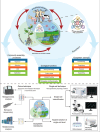Ecosystem Microbiome Science
- PMID: 38818334
- PMCID: PMC10989922
- DOI: 10.1002/mlf2.12054
Ecosystem Microbiome Science
Abstract
The microbiome contributes to multiple ecosystem functions and services through its interactions with a complex environment and other organisms. To date, however, most microbiome studies have been carried out on individual hosts or particular environmental compartments. This greatly limits a comprehensive understanding of the processes and functions performed by the microbiome and its dynamics at an ecosystem level. We propose that the theory and tools of ecosystem ecology be used to investigate the connectivity of microorganisms and their interactions with the biotic and abiotic environment within entire ecosystems and to examine their contributions to ecosystem services. Impacts of natural and anthropogenic stressors on ecosystems will likely cause cascading effects on the microbiome and lead to unpredictable outcomes, such as outbreaks of emerging infectious diseases or changes in mutualistic interactions. Despite enormous advances in microbial ecology, we are yet to study microbiomes of ecosystems as a whole. Doing so would establish a new framework for microbiome study: Ecosystem Microbiome Science. The advent and application of molecular and genomic technologies, together with data science and modeling, will accelerate progress in this field.
Keywords: dynamics; ecosystem; global change; interactions; microbiome.
© 2023 The Authors. mLife published by John Wiley & Sons Australia, Ltd. on behalf of Institute of Microbiology, Chinese Academy of Sciences.
Figures



References
-
- Chapin Iii FS, Matson PA, Vitousek P. Principles of terrestrial ecosystem ecology. New York, NY: Springer; 2011.
-
- Delgado‐Baquerizo M, Oliverio AM, Brewer TE, Benavent‐González A, Eldridge DJ, Bardgett RD, et al. A global atlas of the dominant bacteria found in soil. Science. 2018;359:320–5. - PubMed
-
- Bahram M, Hildebrand F, Forslund SK, Anderson JL, Soudzilovskaia NA, Bodegom PM, et al. Structure and function of the global topsoil microbiome. Nature. 2018;560:233–7. - PubMed
-
- Lee KS, Landry Z, Pereira FC, Wagner M, Berry D, Huang WE, et al. Raman microspectroscopy for microbiology. Nat Rev Methods Primers. 2021;1:80.
LinkOut - more resources
Full Text Sources
